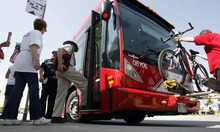This is an archived article that was published on sltrib.com in 2014, and information in the article may be outdated. It is provided only for personal research purposes and may not be reprinted.
Farmington • Davis County officials took a big step Tuesday toward creating a rapid-transit corridor through Bountiful, Woods Cross and North Salt Lake to downtown Salt Lake City.
The Davis County Commission unanimously approved a resolution selecting a preferred route and naming bus rapid transit (BRT) — sort of a light rail on tires — as the preferred transit mode for it initially. Officials kept open the possibility that in the future it could be converted to a TRAX light-rail line.
North Salt Lake, Bountiful and Woods Cross have adopted similar resolutions, which now jointly allow the Utah Transit Authority to finish environmental and planning documents needed for the corridor — and to seek funding for the project, estimated to cost $75 million.
The action comes after UTA studied alternatives for more than a year — getting feedback from public meetings and seeking comment through surveys and social media. The completed study and resolutions also call for increased east-west bus routes in southern Davis County to connect to rapid transit and improve local circulation.
"The people who live there want it, and this is what we should be doing," said Commissioner John Petroff Jr., praising public input that UTA received during its study. "You guys did a great job getting people to show up" to meetings about the project, he told UTA officials.
The new preferred route for the rapid-transit corridor is nearly 12 miles long and would have a dedicated bus-only lane for about half that length.
The new preferred route would go up 400 West in Salt Lake City, sharing regular traffic lanes to Beck Street/U.S. 89. At that point, the bus would have its own lanes as it follows U.S. 89 to Main Street in Bountiful. It would join regular traffic there along Main Street and 500 South and travel to the Woods Cross FrontRunner station.
Jaime White, a UTA engineer, told the commission that BRT is envisioned eventually to also allow quick commutes to the University of Utah without transfers, besides just going to downtown Salt Lake City.
BRT is faster than regular buses in part because of bus-only lanes. Also, tickets are sold before boarding at machines. Entry and exit are allowed at multiple bus doors. Stops are less frequent and farther apart than those for normal buses. Drivers may also manipulate traffic signals somewhat to speed their journey.
UTA currently has one BRT line, on 3500 South in West Valley City, but it has only about 1 mile of bus-only lanes. Other BRT lines are well into the planning stages between Orem and Provo, and Taylorsville and Murray.
White said the final stages of the recent study compared BRT with "enhanced bus," a simpler express bus system. Express bus would have cost $13.9 million compared to $75 million for BRT.
But because of higher ridership from quicker commutes, White said, overall costs after revenue over the long term are actually less for BRT.
Commissioner P. Bret Millburn, who also is Davis County's representative on the UTA Board, said the BRT with permanent buslike stations also is more likely to attract economic development near the route.
Matt Sibul, chief development officer for UTA, said no funding source has yet been identified for the project. He said long-range plans call for developing it within the next 10 years, along with more expanded east-west bus routes in southern Davis County.
UTA normally will wait to identify possible funding for the project, he explained, before proceeding to the next step of detailed environmental analysis and initial design.
Earlier this year, UTA officials asked legislators to raise sales-tax caps for mass transit, but a bill to do that died as the Legislature adjourned. UTA officials had said tax increases would be used to expand bus service that was cut when the recession hit as the agency was vastly expanding TRAX and FrontRunner rail lines.
The amount that Davis County currently charges in sales tax for transit is below existing limits. For every $1 spent in Davis County, UTA now collects just over a half cent in sales tax — 0.55 cent to be exact. In Salt Lake County, taxpayers have approved collecting just over two-thirds of a cent per dollar — 0.68 cent.
Sibul said Davis County officials and business leaders have been exploring whether support exists to raise the sales tax for transit to build projects such as the new BRT line and to expand bus service.
UTA views the BRT line as a first phase for rapid transit in Davis County. UTA information sheets say if future needs arise for expansion into Centerville or Farmington, new studies would look at that. Sibul also said the BRT in the distant future could become a TRAX line — if demand for that develops.



